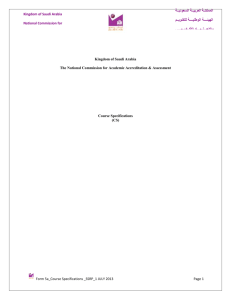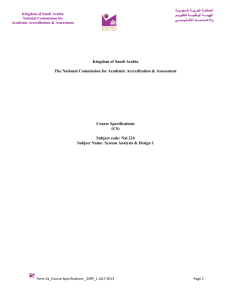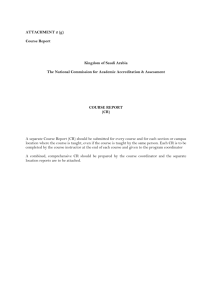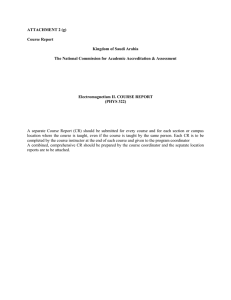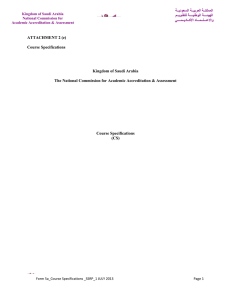PHYS 486-Nanotechnology- Course Desc ription
advertisement
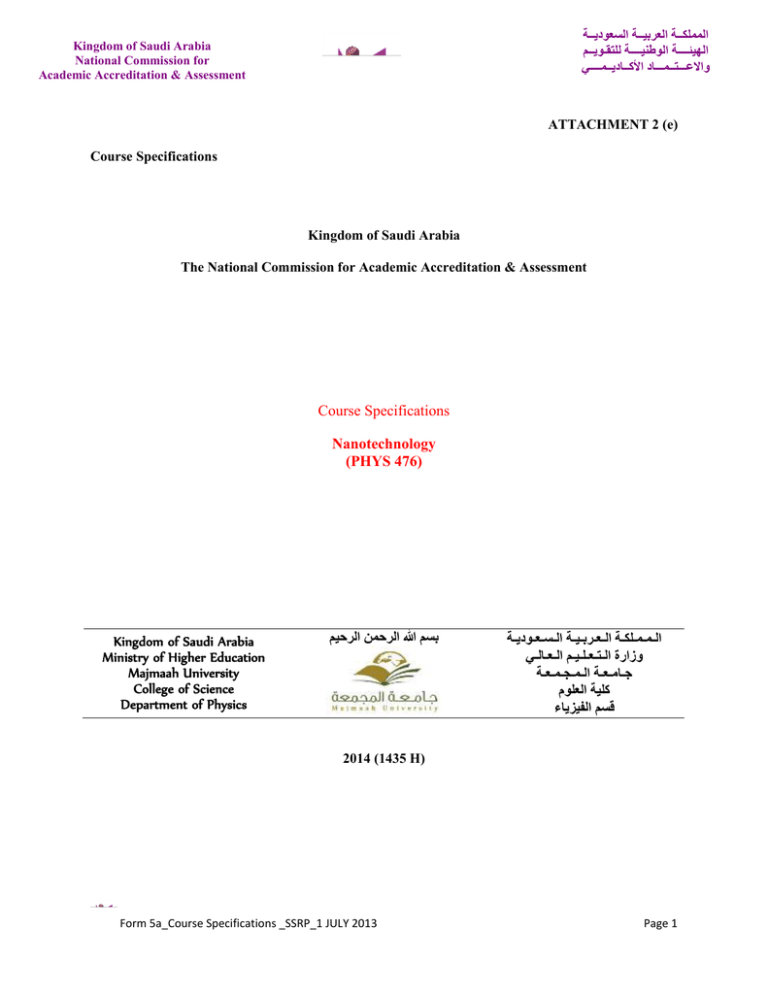
المملكــة العربيــة السعوديــة الهيئــــة الوطنيــــة للتقـويــم واالعـــتــمـــاد األكــاديــمــــي Kingdom of Saudi Arabia National Commission for Academic Accreditation & Assessment ATTACHMENT 2 (e) Course Specifications Kingdom of Saudi Arabia The National Commission for Academic Accreditation & Assessment Course Specifications Nanotechnology (PHYS 476) Kingdom of Saudi Arabia Ministry of Higher Education Majmaah University College of Science Department of Physics بسم هللا الرحمن الرحيم الـمـمـلكـة الـعـربـيـة الـسـعـوديـة وزارة الـتـعـلـيـم الـعـالـي جـامـعـة الـمـجـمـعـة كلية العلوم قسم الفيزياء 2014 (1435 H) Form 5a_Course Specifications _SSRP_1 JULY 2013 Page 1 المملكــة العربيــة السعوديــة الهيئــــة الوطنيــــة للتقـويــم واالعـــتــمـــاد األكــاديــمــــي Kingdom of Saudi Arabia National Commission for Academic Accreditation & Assessment Course Specifications Institution : Majmaah University Date of Report: 20-4-2014 (20/6/1435) College/Department : Zulfi College of Science // Department of Physics A. Course Identification and General Information 1. Course title and code: Nanotechnology // (PHYS 476) 2. Credit hours: 3 Credit hours 3. Program(s) in which the course is offered. (If general elective available in many programs indicate this rather than list programs): BS-Physics, 4 Years Program 4. Name of faculty member responsible for the course Prof. Dr. Abdul Majid Abdul Majeed 5. Level/year at which this course is offered: Optional (6) / 3th Year 6. Pre-requisites for this course (if any): Solid State Physics-1 PHYS 471 7. Co-requisites for this course (if any) No 8. Location if not on main campus : Department of Physics, Zulfi College of Science Al-Zulfi 9. Mode of Instruction (mark all that apply) a. Traditional classroom x What percentage? 80 b. Blended (traditional and online) x What percentage? 20 c. e-learning What percentage? d. Correspondence What percentage? f. Other What percentage? Comments: The mode of instructor is distributed and used two items [Traditional classroom with 80% and Traditional online with 20%] Form 5a_Course Specifications _SSRP_1 JULY 2013 Page 2 Kingdom of Saudi Arabia National Commission for Academic Accreditation & Assessment المملكــة العربيــة السعوديــة الهيئــــة الوطنيــــة للتقـويــم واالعـــتــمـــاد األكــاديــمــــي B Objectives 1. What is the main purpose for this course? a) Aim of this course is to provide a base to students for his future research and study planning. b) After successful completion of this course student will be able to understand Fundamentals of Nanotechnology c) To develop an interest in Student to study more for this emerging nanotechnologies by providing interdisciplinary scientific and engineering knowledge necessary to understand fundamental physical differences at the nanoscale. 2. Briefly describe any plans for developing and improving the course that are being implemented. (e.g. increased use of IT or web based reference material, changes in content as a result of new research in the field) 1. 2. 3. 4. 5. 6. 7. Update the content periodically with reference new development . Using new Book and Journals References. Using Web References. Increase use of IT. Increase use of Video Materials/Animation materials. Introduction of open source specialized software for theoretical work. Proper and increase use of multimedia in class. C. Course Description (Note: General description in the form to be used for the Bulletin or handbook should be attached) A full academic year is equivalent to 36 Credit hour, which each semester is to be 18 Credit hour. Each course is credited with a number of credit hour (>=2) according to the student's workload (contact hours, laboratory work, examination etc) and accumulation of credits hour is accomplished after successful completion of the course. In this case, one Credit hour is equal 25 – 30 student's workload hour. Form 5a_Course Specifications _SSRP_1 JULY 2013 Page 3 المملكــة العربيــة السعوديــة الهيئــــة الوطنيــــة للتقـويــم واالعـــتــمـــاد األكــاديــمــــي Kingdom of Saudi Arabia National Commission for Academic Accreditation & Assessment Lab Total hours tutorials Self- Study Lecture Contact hours Total of contact hours C. Course Description (Note: General description in the form to be used for the Bulletin or Handbook should be attached) (The credit point is equal 25-30 hours ) Historical development of Nanoscience and technology, 6 - - 6 4 2 4 2 18 Formation of energy gap, Discreteness of energy levels 6 - - 6 4 4 2 2 18 Mid-term 1 2 - - 2 Tunneling currents, 3 - - 3 1 2 2 1 9 Formation and characterization of Nanolayers, Applications of Nanolyers, 9 - - 9 4 4 6 3 28 Mid-term 2 2 - - 2 9 - - 9 6 4 6 2 27 6 - - 6 2 4 4 2 18 Review 3 - - 3 1 2 3 9 Final Exam 2 - - 2 Total 48 - - 48 Topic Synthesis and Fabrication of Nanoparticles,Characterizati on and Application of Nanoparticles, Top Down Nanostructuring Techniques, Nanodevices and applications. Internet Library Home Work Discussions 2 2 2 21 3. Additional private study/learning hours expected for students per week. Form 5a_Course Specifications _SSRP_1 JULY 2013 22 24 17 5:15 hours Page 4 132 Kingdom of Saudi Arabia National Commission for Academic Accreditation & Assessment المملكــة العربيــة السعوديــة الهيئــــة الوطنيــــة للتقـويــم واالعـــتــمـــاد األكــاديــمــــي 4. Course Learning Outcomes in NQF Domains of Learning and Alignment with Assessment Methods and Teaching Strategy: For each of the domains of learning shown below indicate: 1. A brief summary of the knowledge or skill the course is intended to develop; 2. A description of the teaching strategies to be used in the course to develop that knowledge or skill; 3. The methods of student assessment to be used in the course to evaluate learning outcomes in the domain concerned. Course Learning Outcomes, Assessment Methods, and Teaching Strategy work together and are aligned. They are joined together as one, coherent, unity that collectively articulate a consistent agreement between student learning, assessment, and teaching. The National Qualification Framework provides five learning domains. Course learning outcomes are required. Normally a course has should not exceed eight learning outcomes which align with one or more of the five learning domains. Some courses have one or more program learning outcomes integrated into the course learning outcomes to demonstrate program learning outcome alignment. The program learning outcome matrix map identifies which program learning outcomes are incorporated into specific courses. On the table below are the five NQF Learning Domains, numbered in the left column. First, insert the suitable and measurable course learning outcomes required in the appropriate learning domains (see suggestions below the table). Second, insert supporting teaching strategies that fit and align with the assessment methods and intended learning outcomes. Third, insert appropriate assessment methods that accurately measure and evaluate the learning outcome. Each course learning outcomes, assessment method, and teaching strategy ought to reasonably fit and flow together as an integrated learning and teaching process. Fourth, if any program learning outcomes are included in the course learning outcomes, place the @ symbol next to it. Every course is not required to include learning outcomes from each domain. Form 5a_Course Specifications _SSRP_1 JULY 2013 Page 5 المملكــة العربيــة السعوديــة الهيئــــة الوطنيــــة للتقـويــم واالعـــتــمـــاد األكــاديــمــــي Kingdom of Saudi Arabia National Commission for Academic Accreditation & Assessment NQF Learning Domains And Course Learning Outcomes 1.0 1.1 1.2 1.3 1.4 1.5 Course Teaching Strategies Knowledge Historical development of Nanoscience and technology Formation of energy gap, Discreteness of energy levels, Tunneling currents, Synthesis and Fabrication of Nanoparticles,Characterization and Application of Nanoparticles, Formation and characterization of Nanolayers, Applications of Nanolyers, Top Down Nanostructuring Techniques, Nanodevices and applications 2.0 Cognitive Skills 2.1 Can conduct general literature survey on particular topic of under study. 2.2 Can correlate and understanding the problem solving techniques 2.3 Able to know some available simulation software for any future research work. 3.0 Interpersonal Skills & Responsibility 3.1 3.2 Work in a group and learn time management. Learn how to search for information through library and internet. 3.3 Course Assessment Methods Present a short report in a written form and orally using appropriate scientific language Form 5a_Course Specifications _SSRP_1 JULY 2013 Developing basic communicative Ability through short and varied situated discourse. Lecturing Team work Exercises Problem solving Class discussion presentation Individual meeting with the instructor (encouraging students to discuss different topics outside the classroom) Discussion with students Making students aware about time management in completing their assignments and projects. Counsel students how to make a good presentation . Encourage students to help each other Group presentation Group assignments Homework. Group Discussion Presentation Mid-term exams Terminal Exam. (Final Exam) Class Participation Presentation Essay Question Research Respecting dead lines. Showing active class participation. Helping other students to understand tasks in the class. Giving clear and logical arguments Performing seriously on midterms and final exams Page 6 المملكــة العربيــة السعوديــة الهيئــــة الوطنيــــة للتقـويــم واالعـــتــمـــاد األكــاديــمــــي Kingdom of Saudi Arabia National Commission for Academic Accreditation & Assessment 4.0 4.1 4.2 4.3 5.0 Communication, Information Technology, Mathematical Methods Take part in discussion with teacher, ask questions, solve problems, and use computers. Interpret/operate Nanomaterials and their formation and properties. Rise to the point questions during the lecture, work in groups, and communicate with class fellows and with me electronically, and periodically visit the web sites I recommended. Students use information technology in the classroom Exercises Problem solving oral quizzes Essay questions Encourage students to use program soft wear Write reports Exercises related to specific topics Psychomotor 5.1 5.2 5- Please fill in this table based on the following criteria: 1. Based on your course syllabus, provide 3 - 5 major course objectives in column 1 along with 2 - 3 outcomes for each objective in column 2. 2. In column 3, indicate how the objectives and outcomes in column 1 and 2 map into ME Program Learning Outcomes (PLO) 3. In column 3, indicate how the objectives and outcomes in columns 1 and 2 map into the NCAAA Outcomes 4. In column 4, indicate how the objectives and outcomes in columns 1 and 2 map into the Asiin criteria 5- Learning outcomes in step 2, 3, 4 are listed in (Physics Program Guidance) Course Objectives: The student get the basics knowledge of Physics of Nanomaterials. Course Outcomes: PLO NCAAA ASIIN Easily understand about the dimensionality associated with the materials 1, 2 1 a, b Check and apply the different properties of Materials at Nanoscale . 8,9 2,3 b, 3,4 1,3 c, h 2,4 3 C, h Use the information about the formation of energy gap and Discreteness of energy levels for its application. Understand different techniques use for the formation and synthesis of nanoparticles and structures. Form 5a_Course Specifications _SSRP_1 JULY 2013 Page 7 المملكــة العربيــة السعوديــة الهيئــــة الوطنيــــة للتقـويــم واالعـــتــمـــاد األكــاديــمــــي Kingdom of Saudi Arabia National Commission for Academic Accreditation & Assessment Collect general information about 7 6,7 H,f 8,9 8 G 6,7 9 H Learn how to search for information through library and internet. 10, 14 11 Gh Present a short report in a written form and orally on given topics. 12,18 10,12 J,k Understand Synthesis and Fabrication of Nanoparticles,Characterization and Application of Nanoparticles and their applications 14,17 13 I Nanoscience and technology Learn, understand and get concepts of nanoscale. The development of students' intellectual abilities. Apply the gained information that how to use the Nanoscience and technology in different fields. Work in a group and learn time management. 5. Schedule of Assessment Tasks for Students During the Semester 1 Assessment task (e.g. essay, test, group project, examination, speech, oral presentation, etc.) First exam* 2 Second exam* 3 Lab. Exam - 4 Presentation One/ semester 5 Homework Every week 6 Quizzes End topics 7 Discussions Every week 8 Team group Three time/ semester 9 Tutorials 10 Computer tools used 11 Project Week Due 6 Proportion of Total Assessment 20% 12 20% 20% Every sub topic Every report and presentation - 12 Peer project - 13 Final exam * End of the semester Total 40% 100 % *First exam, second exam and final exam are written exam Form 5a_Course Specifications _SSRP_1 JULY 2013 Page 8 Kingdom of Saudi Arabia National Commission for Academic Accreditation & Assessment المملكــة العربيــة السعوديــة الهيئــــة الوطنيــــة للتقـويــم واالعـــتــمـــاد األكــاديــمــــي D. Student Academic Counseling and Support 1. Arrangements for availability of faculty and teaching staff for individual student consultations and academic advice. (include amount of time teaching staff are expected to be available each week) Four office hour per week for Student Academic Counseling and Support /, 1. List Required Textbooks 1. R. Fahrner 2010 “Nanotechnology and Nanoelectronics Materials, Devices, Measurement Techniques”. Springer 2. List Essential References Materials (Journals, Reports, etc.) 1. Guo Zhong Cao 2011 “Nanostructures and Nanomaterials synthesis, properties and applications ” Imperial college press 2. Fritz H. Frimmel and R. Niessner 2010 “Nanoparticles in the Water Cycle: Properties, Analysis and Environmental Relevance” Springer 3. List Recommended Textbooks and Reference Material (Journals, Reports, etc) 1. Nature Nanotechnology, by Nature Publishing Group, 2. Nano Letters, by American Chemical Society, 3. Small, by Wiley-VCH, 4. Nano Today, by Elsevier, 5. Lab on a Chip, by Royal Society of Chemistry, 6. Nanotechnology, by Institute of Physics 7. Current Nanoscience, by Bentham Science 4. List Electronic Materials (eg. Web Sites, Social Media, Blackboard, etc.) en.wikipedia.org http:// faculty/aabdulmjid.edu.sa Next Big Future: A look at what our future could look like, with the help of nanotech. Nanotechnology Today: The latest information and news related to nanotechnology and more. Nanotechnology Development Blog: Learn about how nanotech is developing and read about the latest breakthroughs. Nanotechnology Now: News and information related to nanotechnology and related developments. Nanotechnology News and Information: Just what it sounds like, this blog features the latest in news on nanotech, as well as jobs in the field. 5. Other learning material such as computer-based programs/CD, professional standards or regulations and software. Form 5a_Course Specifications _SSRP_1 JULY 2013 Page 9 Kingdom of Saudi Arabia National Commission for Academic Accreditation & Assessment المملكــة العربيــة السعوديــة الهيئــــة الوطنيــــة للتقـويــم واالعـــتــمـــاد األكــاديــمــــي MATHEMATICA, MATLAB, MathCAD MS Office (particularly MS Excel) Virtual NanoLab F. Facilities Required Indicate requirements for the course including size of classrooms and laboratories (i.e. number of seats in classrooms and laboratories, extent of computer access etc.) 1. Accommodation (Classrooms, laboratories, demonstration rooms/labs, etc.) Furnished Lecture Room equipped with smart board and computer Lab for nanotechnology Fabrication and Characterization (for Future improvement) 2. Computing resources (AV, data show, Smart Board, software, etc.) Computational Lab with proper software 3. Other resources (specify, e.g. if specific laboratory equipment is required, list requirements or attach list) Library, and Seminar Room , Wi-Fi Internet Connections G Course Evaluation and Improvement Processes 1 Strategies for Obtaining Student Feedback on Effectiveness of Teaching Course/module evaluation system electronically organized by the University 2 Other Strategies for Evaluation of Teaching by the Program/Department Instructor department has its own teacher evaluation committee 3 Processes for Improvement of Teaching Course report. Program report. Training Courses Form 5a_Course Specifications _SSRP_1 JULY 2013 Page 10 Kingdom of Saudi Arabia National Commission for Academic Accreditation & Assessment المملكــة العربيــة السعوديــة الهيئــــة الوطنيــــة للتقـويــم واالعـــتــمـــاد األكــاديــمــــي 4. Processes for Verifying Standards of Student Achievement (e.g. check marking by an independent member teaching staff of a sample of student work, periodic exchange and remarking of tests or a sample of assignments with staff at another institution) Mechanism is available for verification of Standards by Course committee for each course/Module Course Committee Check each results and student answer sheet Course file maintained by teacher along with highest, middle and lowest grade student’s answer sheets Periodically improvement in course content with insertion the latest developments in the field Form 5a_Course Specifications _SSRP_1 JULY 2013 Page 11 المملكــة العربيــة السعوديــة الهيئــــة الوطنيــــة للتقـويــم واالعـــتــمـــاد األكــاديــمــــي Kingdom of Saudi Arabia National Commission for Academic Accreditation & Assessment 5 Describe the planning arrangements for periodically reviewing course effectiveness and planning for improvement. 1- Course Evaluation 2- Exam Evaluation 3- Improvement plan 4- Program Outlearning with course outlearning 5- Outlearning from the pre-requisite course Faculty or Teaching Staff: ______ Prof. Dr. Abdul Majid Abdul Majeed____________________ Signature: _______________________________ Date Report Completed: __April 24, 2014_____ Received by: _____________________________ Dean/Department Head: ___________________ Signature: _______________________________ Date: _______________ Form 5a_Course Specifications _SSRP_1 JULY 2013 Page 12
